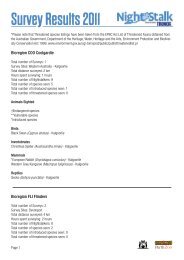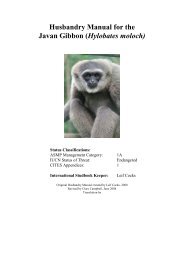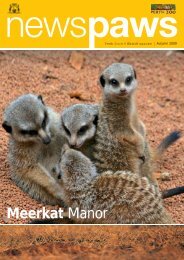Summer 2009 - Perth Zoo
Summer 2009 - Perth Zoo
Summer 2009 - Perth Zoo
Create successful ePaper yourself
Turn your PDF publications into a flip-book with our unique Google optimized e-Paper software.
Ultrasounding<br />
<strong>Perth</strong> <strong>Zoo</strong>’s Botanic Heritage<br />
You’ve heard of ultrasounding<br />
pregnant women to make sure<br />
their unborn child is healthy,<br />
but have you heard of<br />
ultrasounding trees?<br />
<strong>Perth</strong> <strong>Zoo</strong> has kept many plant<br />
species which were originally planted<br />
under the guidance of the <strong>Zoo</strong>’s<br />
head gardener, Harry Steadman,<br />
from 1899–1929. In order to keep<br />
these and other trees healthy, a lot<br />
of work needs to be done by our<br />
present-day horticulturists.<br />
<strong>Perth</strong> <strong>Zoo</strong> horticulturists examine<br />
trees for signs of decay or distress<br />
such as poorly tapered branches,<br />
buckling, loose bark or cracks. This<br />
is especially important when you’re<br />
looking at trees that are over 100<br />
years old and have seen many<br />
seasons, storms and changes.<br />
Internal problems are obviously more<br />
difficult than external ones but that<br />
doesn’t mean they should be<br />
overlooked. This is where ultrasound<br />
comes in.<br />
The PiCus ® machine is just one of<br />
the tools that arborists – or tree<br />
surgeons – use to assess the tree’s<br />
health and whether there is any<br />
internal decay or damage.<br />
Likened to an ultrasound machine,<br />
it provides a non-invasive way to<br />
detect poor health in trees. Sound<br />
waves are transmitted through a<br />
degraded section of the branch or<br />
trunk and a sectioned image, or<br />
tomogram, is produced.<br />
The image is colour-coded and<br />
shows healthy, altered and decayed<br />
woods, allowing the arborist to<br />
determine whether the tree poses<br />
any risk. The limb or section of the<br />
tree is removed if necessary.<br />
“<strong>Perth</strong> <strong>Zoo</strong> is probably the healthiest<br />
park or plant collection I have ever<br />
come across in my 35 years in the<br />
industry,” says <strong>Perth</strong> <strong>Zoo</strong> Horticulture<br />
Curator Andrew Blake.<br />
“I can see two reasons for this: great<br />
plant diversity and the presence of<br />
animals. These are also the reasons<br />
for the good health found in<br />
undisturbed bush areas.<br />
“This means our botanic collection is<br />
in such good health that the trees<br />
Above: Bowden Tree Consultancy<br />
tomogram generated using the PiCus ® .<br />
machine. Right: Bowden Tree Consultant<br />
using the PiCus ® . machine.<br />
Photos courtesy of Bowden Tree<br />
Consultancy.<br />
live longer than in many other parks<br />
and gardens. Just like elderly people<br />
or animals, old trees can have trouble<br />
with strength in their limbs or being<br />
affected by extremes such as storms<br />
and being knocked so they require<br />
careful management. Tomograms are<br />
another tool in helping us keep the<br />
<strong>Zoo</strong>’s botanic collection healthy.”<br />
If a branch needs to be removed,<br />
that doesn’t mean it’s no longer<br />
useful. <strong>Perth</strong> <strong>Zoo</strong> keepers are always<br />
on the hunt for branches that can be<br />
used in exhibits as behavioural<br />
enrichment, to help stimulate<br />
climbing, curiosity and other natural<br />
behaviours in their animals.<br />
“Whenever we’re pruning and have to<br />
remove a limb we need to be careful<br />
not to cut it up too quickly. The<br />
keepers are always looking for ‘exhibit<br />
furniture’ and often need a branch that<br />
is shaped ‘just so’,” says Mr Blake.<br />
So what is the result of our<br />
horticulturists’ hard work? The great<br />
ambiance and feeling of immersion<br />
you experience when you walk into<br />
one of the <strong>Zoo</strong>’s geographical zones<br />
and see plants that reflect the native<br />
vegetation of an African savannah,<br />
native Australian bushland or Asian<br />
rainforest, as well as some very<br />
healthy animals.<br />
<strong>Summer</strong> <strong>2009</strong>/10 | newspaw s<br />
3






